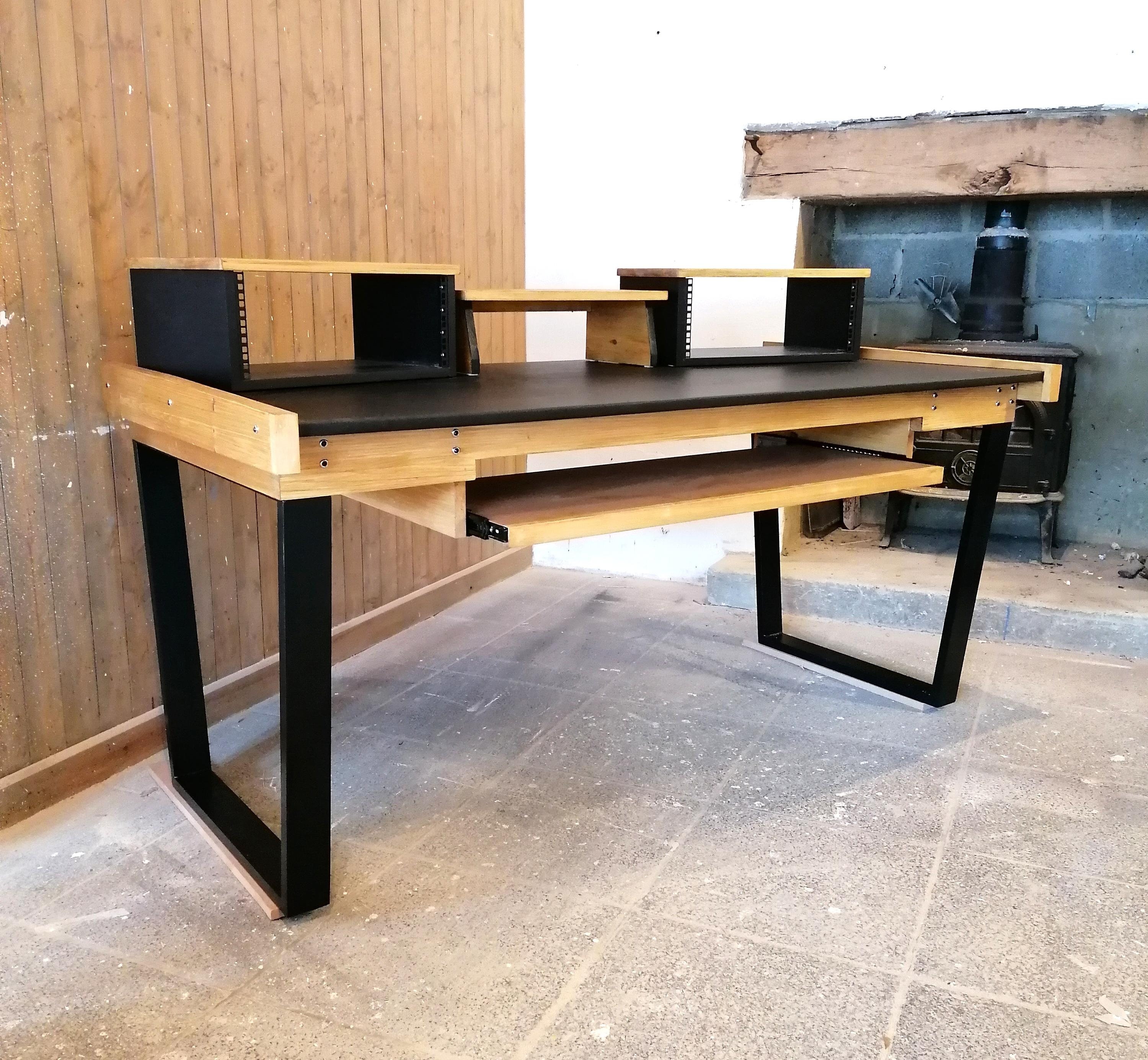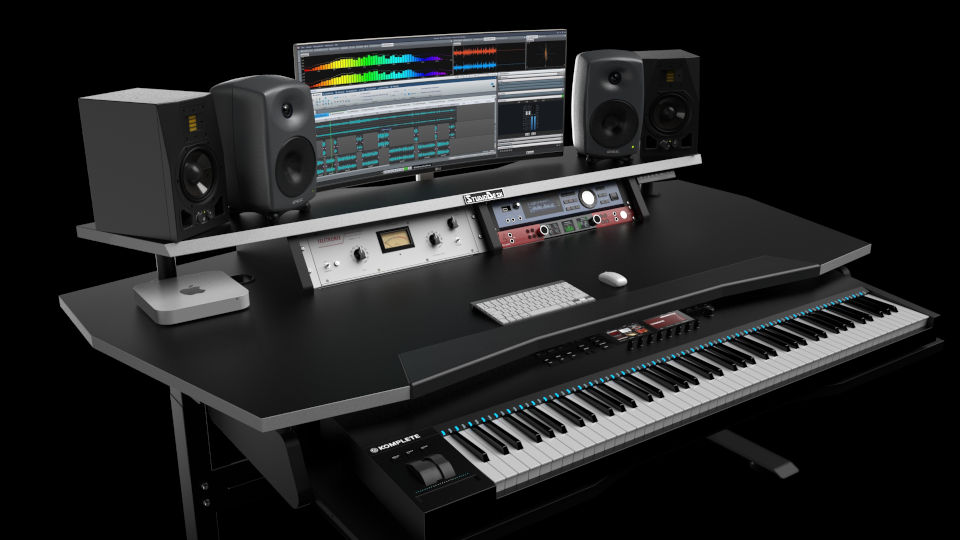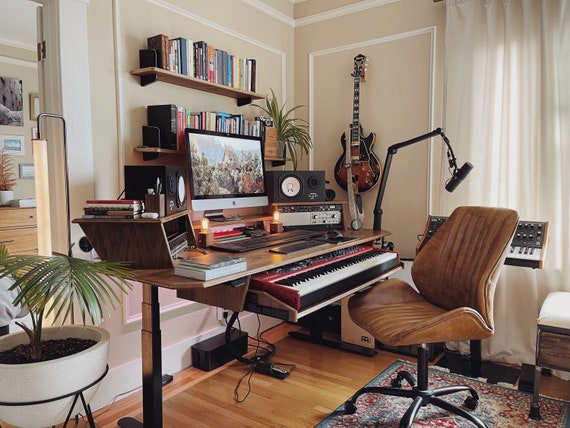A studio desk is a workstation designed for music producers, sound engineers, and other professionals who require a comfortable and ergonomic working space to manage their equipment and deliver high-quality results. It is typically equipped with a desktop surface, shelves, racks, and drawers to hold mixing consoles, speakers, monitors, computers, and other peripherals.
Studio desks have become an essential piece of furniture in modern recording studios, home recording setups, and video editing rooms. They provide not only a functional working environment but also an aesthetic appeal with their sleek and elegant designs. Choosing the right studio desk is crucial to maximize productivity and enhance your creativity.
This article aims to provide you with comprehensive guidance on how to select the ideal studio desk for your needs and budget.
Design And Features
The studio desk boasts an ergonomic design that ensures maximum comfort, efficiency, and utility. It features ample space for accommodating monitors, keyboards, controllers, speakers, and other hardware accessories. The desk is also designed with cord management systems to minimize clutter and maximize organization.
A well-designed studio desk is a key piece of furniture that every musician, producer, or sound engineer needs. Not only should it be sturdy and durable, but it should also be designed to enhance the workflow and ensure the best sound quality. A studio desk with a sleek and modern design can also inspire creativity and help organize your workspace. In this article, we will be discussing the various features and design aspects that make a perfect studio desk.
Ergonomics Of A Studio Desk
Ergonomics is an essential factor to consider when choosing a studio desk. A desk that is too high or too low can cause discomfort and lead to long-term health problems. The ideal studio desk should allow you to position your arms in a comfortable and relaxed position, with the monitor at the correct height to avoid eye and neck strain. Additionally, the keyboard tray should be at the right angle to prevent wrist injuries.
Built-in Cable Management
A messy workspace can be distracting and affect your productivity. That’s why a studio desk with built-in cable management is a must-have feature. It helps keep all the cables organized and tidy, preventing tangling, knots, and dust. Some desks offer zip-ties or clips to hold cables in place or cable routing channels to hide cables from sight. This feature not only improves the aesthetic appeal of the desk but also helps maintain the overall longevity of the setup.
Speaker Isolation Pads
If you are a sound professional, you know how crucial it is to isolate your speakers from external vibrations to achieve the best sound quality. Speaker isolation pads absorb the unwanted frequencies that resonate through the desk and can lead to loss of sound quality. These pads are made of high-density foam and offer a non-slip surface, ensuring the speakers do not move or skid while in use. Studio desks with built-in speaker isolation pads make for an efficient setup, saving you both time and effort.
Storage Options
Every studio desk needs ample storage to keep the workspace clean and organized. A desk with built-in storage options such as drawers, shelves or cabinet space, provides plenty of room to store all the necessary equipment needed during the recording process. Drawers can hold papers, documents, and small items while storage shelves can store books, cables, or even a small keyboard. Some desks offer modular storage options that can be customized to your specific needs.
Material And Construction Quality
A studio desk is not something you want to replace every year, so it is essential to choose one made of quality materials that can withstand the wear and tear of everyday use. The construction quality should be top-notch, with durable joints, sturdy legs, and a smooth finish. Desks made from solid wood or metal frames are known for their durability and make for a long-lasting investment. Moreover, a studio desk with a painted or laminated surface is more resistant to scratches and stains, improving the lifespan of your desk. In conclusion, a well-designed studio desk can help increase productivity, improve acoustics and ultimately enhance your final product. Features such as ergonomic design, built-in cable management, speaker isolation pads, and ample storage options, all play an important role in making a perfect desk for sound professionals. Choosing a desk made of top-quality materials also ensures longevity, making it an investment worth considering.

Credit: www.etsy.com
Types Of Studio Desks
Studio desks come in various types to suit the different needs of music producers and audio engineers. The types include the traditional workstation, the L-shaped desk, the corner desk, the adjustable height desk and the modular desk.
Studio desks are a crucial component for music producers and sound engineers. A high-quality studio desk helps to maintain the right posture while working, and it can also be a great asset to enhance your studio’s overall aesthetic appeal. When it comes to studio desks, there are several types available in the market which are designed to cater to different requirements.
Standard Studio Desk
The Standard Studio Desk is perfect for music producers with a limited workspace. It’s a simple yet effective desk that ensures smooth workflow. It usually comes with a keyboard tray, a monitor shelf, and space to house your studio monitors. Additionally, it may have a dedicated space for your computer or laptop. The desk is designed to support your arms and wrists while working to prevent fatigue.
Corner Studio Desk
Corner Studio Desks are a great option if you have a confined room or if you need your desk to be out of the way. It makes good use of the corner space and comes with plenty of desk space. The desk provides a 90-degree angle that allows the music producer to have a comfortable and natural view of the screen. The screen must be kept at least an arm’s length away from the eyes.
Adjustable Height Studio Desk
If you have back problems or have a tall build, then the Adjustable Height Studio Desk might be best suited for you. These desks come with adjustable legs that allow you to adjust the height of your desk. The desk can be raised to a level that suits your height, ensuring good posture and preventing back pain. These adjustable desks come with a premium price tag, but they are an excellent investment in the long run.
L-shaped Studio Desk
The L-Shaped Studio Desk provides ample space to work with, making it the perfect option if you’re running a recording studio with multiple equipment pieces. The desk provides multiple surfaces to place your studio equipment, including your computer, mixing console, studio monitors, and more. With an L-Shaped desk, you can efficiently manage your studio’s workflow, enhancing productivity, and maximizing space in the studio.
Custom-built Studio Desk
Finally, if you have a unique requirement that is not met by the standard desks available in the market, then the Custom-Built Studio Desk is the way to go. Custom-built desks are specifically designed to cater to your needs, ensuring the perfect space and storage for you and your equipment. They may cost more than standard desks, but the convenience and comfort they offer are incomparable. In conclusion, choosing the right studio desk plays a vital role in enhancing productivity and workflow in your recording studio. Regardless of the type of desk you choose, always ensure that it provides comfort, ample workspace, and easy accessibility to your equipment.
Factors To Consider While Choosing A Studio Desk
A studio desk is an essential piece of furniture for any music producer, sound engineer, or video editor. It provides a comfortable workspace and storage for your equipment. When choosing a studio desk, there are various factors you need to consider.
Size And Shape
The size and shape of the desk are critical factors to consider. You need to take into account the space available in your studio and the number of equipment you have. If you have a small studio, a compact desk would be the best option. On the other hand, if you have a lot of equipment, you might need a desk with multiple tiers or shelves.
Usage
Another key factor to consider when choosing a studio desk is usage. Think about how you plan to use it. If you work with multiple monitors, you need a desk with enough space to accommodate them. If you are a music producer, you might want a desk with a keyboard tray. Make sure the desk you choose fits your specific needs.
Budget
Studio desks come in different price ranges. Some are affordable, while others are expensive. When choosing a desk, you need to consider how much you are willing to spend. Keep in mind that a higher price does not always mean better quality. Research the different types of desks available to find one that suits your needs and budget.
Aesthetics
While functionality is critical, aesthetics cannot be ignored. The desk you choose should complement the style of your studio. For instance, if you have a modern studio, you might want a desk with a sleek, minimalistic design. If your studio has a classic look, a wooden desk would be a great option.
Future Upgradability
Finally, you need to think about future upgradability. It is essential to choose a desk that can accommodate future upgrades and additional equipment. The desk you choose should be adaptable enough to accommodate different gear setups. Consider choosing a desk that has extra slots, shelves, or compartments that can be added or removed.

Credit: www.studiodesk.net
Setting Up A Studio Desk
If you are someone who works with video or music production, you understand the importance of a well-equipped studio. A studio desk is a crucial component of any studio, and how it is set up can make all the difference in the quality of your work. Here we will discuss the key factors you need to consider when setting up your studio desk.
Positioning Of The Desk
The position of your desk is essential when setting up your studio. You want to ensure that it is positioned in a way that optimizes your workflow while creating a comfortable work environment. Your desk should be located facing away from the wall, to allow for easy access to your equipment and prevent distracting reflections. You should be able to turn your chair easily to access any equipment you need during a project.
Studio Monitor Placement
When it comes to setting up your studio desk, the placement of your studio monitors is critical. Your speakers should be at an equal distance from each other and at ear level. A common placement technique is placing your speakers in an equilateral triangle with your head, forming a 60-degree angle. Doing so will result in a more balanced and accurate sound while producing music or videos.
Acoustic Treatment
Acoustic treatment is another crucial aspect of your studio setup. If your studio has too many reflective surfaces, such as walls, floors, and ceilings, it may create unwanted echoes, making it challenging to record high-quality audio. Acoustic treatments like sound-absorbing wall panels, bass traps, and diffusers can help reduce reflections and improve the overall quality of sound in your studio.
Optimizing The Workstation
Optimizing your workstation is vital for a comfortable and efficient workspace. Ensure that your desk is the correct height according to your individual needs to prevent neck and back pain. Organize your workspace to suit your needs, such as cable management and access to your equipment. A well-organized workspace can increase your efficiency and productivity.
Conclusion
Maintenance And Care
Proper maintenance and care of your studio desk is essential to ensure long-lasting durability and functionality. Regularly cleaning and dusting the surface, avoiding excessive weight on the desk, and using coasters for drinks can all help to extend the life of your workspace.
Maintenance and Care: Taking care of your studio desk is crucial to ensure its longevity and optimal performance. Proper maintenance and care can not only keep your desk looking new, but it can also help prevent potential damage. In this section, we’ll take a closer look at how to clean and dust your desk, avoid scratches and water damage, and explore options for repair and replacement. Cleaning and Dusting: Regular cleaning and dusting is essential to keep your studio desk looking fresh and new. To clean your desk, start by wiping it down with a dry microfiber cloth to remove any dust or debris. If there are stains or grime, you can use a mild cleaning solution and a soft cloth to wipe down the surface gently. Avoid using harsh chemicals or abrasive cleaners that may damage the finish of your desk. Avoiding Scratches and Water Damage: Scratches and water damage can be detrimental to the appearance and functionality of your studio desk. To avoid scratches, make sure to place any objects on the desk gently and use coasters for drinks. If you need to move equipment or furniture, use protective pads to prevent scratches. For water damage, wipe up any spills immediately and avoid placing drinks or other liquids directly on the desk. Repair and Replacement Options: Despite your best efforts, accidents can happen, and you may need to repair or replace your desk. If the damage is minor, it may be possible to fix it yourself using touch-up paint or wood filler. For more extensive damage, it may be worth contacting a professional to evaluate the repair options. If the damage is beyond repair, you may need to consider replacing the desk. Check with the manufacturer or seller to see if your desk is still under warranty or if there are replacement parts available. By following these maintenance and care tips, you can help ensure your studio desk stays in top shape for years to come.
Reviews Of Popular Studio Desk Models
Choosing the right studio desk is crucial for music producers, sound designers, and video editors. A good studio desk should provide ample space for your equipment, facilitate comfortable and efficient workflow, and enhance the overall look of your workspace. However, with so many brands and models available in the market, finding the perfect studio desk can be a daunting task. To help you make an informed decision, we have reviewed some of the popular studio desk models from different brands.
Brand A Studio Desk:
Brand A offers a range of studio desks that cater to different needs and budgets. Their flagship model is the XYZ Studio Desk, which features a sturdy frame made of steel and hardwood, and a spacious tabletop with room for multiple monitors, laptops, and desktops. The desk also has built-in cable management and height-adjustable legs that make it comfortable for long sessions. Users have praised the desk’s durability, functionality, and aesthetic appeal.
Brand B Studio Desk:
Brand B is known for its high-end studio furniture that combines elegance with utility. Their signature model is the ABC Studio Desk, which boasts a minimalist design with clean lines and smooth surfaces. The desk is made of premium-grade materials such as solid oak, walnut, and steel, and features multiple slots, shelves, and drawers for storing and organizing your gear. Users have praised the desk’s craftsmanship, attention to detail, and ergonomics.
Brand C Studio Desk:
Brand C specializes in studio furniture that blends vintage and modern elements. Their flagship model is the DEF Studio Desk, which has a retro-inspired design with curved edges, tapered legs, and a distressed finish. The desk is made of reclaimed wood and metal, and features a large tabletop with a built-in monitor shelf, keyboard tray, and storage cabinet. Users have praised the desk’s unique design, rustic charm, and value for money.
Brand D Studio Desk:
Brand D caters to budget-conscious buyers who need a functional and stylish studio desk. Their popular model is the GHI Studio Desk, which has a sleek and simple design with a black or white finish. The desk is made of lightweight and durable materials such as MDF and metal, and features a compact tabletop with a riser that can hold a monitor or laptop. Users have praised the desk’s affordability, portability, and ease of assembly.

Credit: www.etsy.com
Frequently Asked Questions On Studio Desk
What Is A Studio Desk?
A studio desk is a specialized piece of furniture designed for music production or audio recording. It usually has a large workspace, storage shelves or compartments for equipment, and may include features like cable management or ergonomic design.
Why Do I Need A Studio Desk?
A studio desk can help you organize your gear and create a more efficient workspace for your music production or audio recording needs. It can also enhance your creativity by providing a comfortable and ergonomic environment to work in.
What Size Should My Studio Desk Be?
The size of your studio desk will depend on your specific needs and available space. Consider the size of your equipment, the amount of storage you require, and the physical dimensions of your workspace when selecting a desk.
What Materials Are Studio Desks Made Of?
Studio desks are often made of high-quality materials like wood, metal, or glass. Different materials offer different aesthetics, durability, and functionality, so choose the materials that best suit your needs and budget.
Conclusion
A studio desk is essential for any music producer, writer, or designer working from home or in a small studio. While there are plenty of options available on the market, finding one that combines functionality, ergonomics, and durability can be a challenge.
By doing your research, you can find the perfect desk that suits your needs and takes your creative work to the next level. Invest in a high-quality studio desk, and you’ll see a significant improvement in your productivity and comfort.
Happy crafting!